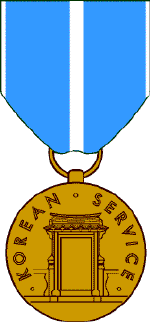Korean Service Medal
| Korean Service Medal | |
|---|---|
 Korean Service Medal | |
| Type | Campaign Medal |
| Description | Obverse: On a bronze medal, 1-1/4 inch in diameter, a Korean gateway, encircled by the inscription "KOREAN SERVICE". Reverse: On the reverse is the Korean "taegeuk" symbol taken from the center of the Korean National flag with the inscription "UNITED STATES OF AMERICA" and a spray of oak and laurel encircling the design. Ribbon: The ribbon is 1-3/8 inches wide and consists of the following stripes: 1/32 inch White; 19/32 inch Bluebird; center 1/8 inch White; 19/32 inch Bluebird; and 1/32 inch White |
| Eligibility | Military service during Korean War |
| Campaign(s) | Korean War |
| Status | Inactive |
| Established | EO 10179, November 8, 1950, as amended[1] |
Korean Service Medal ribbon & streamer | |
| Precedence | |
| Next (higher) | National Defense Service Medal |
| Next (lower) | Antarctica Service Medal |
| Related | Korean War Service Medal (Korea) Korean Defense Service Medal United Nations Korea Medal Korean War Service Medal Presidential Unit Citation (Korea) |
The Korean Service Medal (KSM) is an award of the United States Armed Forces and was created in November 1950 by executive order of President Harry Truman. The Korean Service Medal is the primary United States medal for participation in the Korean War and is awarded to any U.S. service member, who performed duty in the Republic of Korea, between June 27, 1950 and July 27, 1954.[2][3] The United States Department of Defense declared thirteen official campaigns of the Korean War, all of which are annotated by service stars on the Korean Service Medal. Some campaigns apply to all branches of the U.S. military, while others are branch specific. Service stars are authorized to the Korean Service Medal for participation in the following campaigns.
- North Korean Aggression (USMC, Navy): June 27 to November 2, 1950
- United Nations Defensive (Army, USAF): June 27 to September 15, 1950[4]
- Inchon Landing (USMC, Navy): September 13 to 17, 1950
- United Nations Offensive (Army, USAF): September 16 to November 2, 1950[4]
- Chinese Communist Forces Intervention (Army, USAF): November 3, 1950 to January 24, 1951[4]
- Communist China Aggression (USMC, Navy): November 3, 1950 to January 24, 1951
- First United Nations Counteroffensive (USMC, Army, Navy, USAF): January 25 to April 21, 1951[4]
- Chinese Communist Forces Spring Offensive (USMC, Army, Navy, USAF): April 22 to July 8, 1951[4]
- United Nations Summer-Fall Offensive (USMC, Army, Navy, USAF): July 9 to November 27, 1951[4]
- Second Korean Winter (USMC, Army, Navy, USAF): November 28, 1951 to April 30, 1952[4]
- Korean Defense Summer-Fall, 1952 (USMC, Army, Navy, USAF): May 1 to November 30, 1952[4]
- Third Korean Winter (USMC, Army, Navy, USAF): December 1, 1952 to April 30, 1953[4]
- Korea, Summer 1953 (USMC, Army, Navy, USAF): May 1 to July 27, 1953[4]
For those Army personnel who participated in the amphibious landing at Inchon, as well as airborne attacks on Sukch'on-Such'on and Musan, an arrowhead device is authorized in addition to campaign service stars. The Fleet Marine Force combat operation insignia is also authorized for Naval personnel who served with the Marine Corps at any time during the Korean War.
Although an armistice ended combat operations in Korea on 27 July 1953, the Korean Service Medal was issued until June 1954 due to the tense nature of the occupation and garrison duty immediately after the armistice, as well as the high possibility of a renewed attack by North Korea. After 1954, the Korean Service Medal was no longer issued although the Armed Forces Expeditionary Medal was authorized for Korean service in the 1960s. As of 2004, a new medal known as the Korea Defense Service Medal was authorized for all post-Korean War service in the Republic of Korea.
The color scheme of the ribbon is derived from the Flag of the United Nations, as it was under the auspices of the United Nations (United Nations Security Council Resolution 82) that the war was conducted. The medal itself features a "Korean gateway," most likely an iljumun.
The United Nations Korea Medal was usually granted along with the Korean Service Medal. Also, a similar award to the Korean Service Medal, known as the Korean War Service Medal, is a foreign medal of South Korea and is awarded to any United States service member who received the Korean Service Medal. The Republic of Korea Presidential Unit Citation is also retroactively authorized to any United States Army veteran who served during the Korean War.
It is believed that the Korean Service Medal, along with the other awards that were awarded during the Korean war, may possibly be declared active again due to a guarding conflict currently being held in Korea, henceforth the reasons for the Korea Defense Service Medal still being currently awarded.
See also
References
- ^ Amended by EO 10429, January 17, 1953, and EO 13286, February 28, 2003. Additional details and descriptions given at 32 CFR 578.44.
- ^ "Korean Service Medal". U.S. Navy Service and Campaign Medals. Naval History and Heritage Command.
- ^ Institute of Heraldry Korean Service Medal
- ^ a b c d e f g h i j "Fact Sheet: Korean Service Medal". Air Force Personnel Center.
